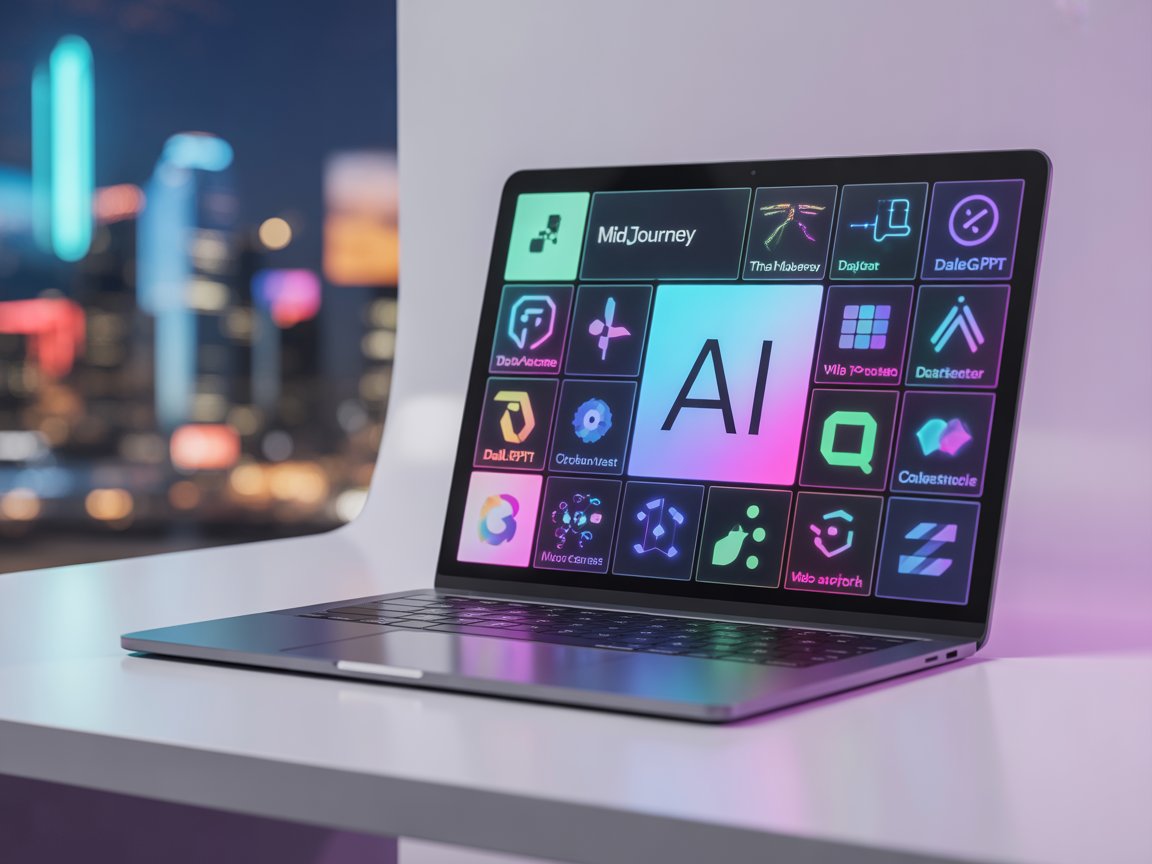Best AI Tools for Content Creators in 2025: The Ultimate Creator’s Toolkit
Did you know that 87% of content creators using AI tools report a 300% increase in productivity, yet 64% still rely on outdated manual processes that consume 70% of their creative time? The landscape of artificial intelligence has revolutionized content creation in 2025, with advanced AI tools now capable of generating human-quality videos, writing compelling copy, and even composing original music in minutes rather than hours. From solo YouTubers to enterprise marketing teams, creators who embrace these cutting-edge AI solutions consistently outperform their competitors by producing more engaging content faster, cheaper, and with greater consistency than ever thought possible.
Essential AI Tools Arsenal for Modern Content Creation
Build your comprehensive content creation toolkit with these game-changing AI solutions:
Core Content Generation Tools:
- ChatGPT-4 Turbo: Advanced language model for writing, brainstorming, and content planning ($20/month)
- Claude 3.5 Sonnet: Superior reasoning capabilities for complex content analysis and research
- Jasper AI: Marketing-focused copywriting with brand voice training ($49/month)
- Copy.ai: Social media content and ad copy generation with templates ($36/month)
- Writesonic: SEO-optimized articles and blog posts with real-time optimization
Visual and Video Creation Powerhouses:
- Midjourney v6: Photorealistic image generation with artistic control ($30/month)
- DALL-E 3: Integrated image creation with precise text prompt following
- Runway ML: Professional video editing with AI-powered effects and transitions ($35/month)
- Synthesia: AI avatar video creation for educational and marketing content ($90/month)
- Canva Magic Studio: Comprehensive design suite with AI-enhanced templates
Audio and Music Production Suite:
- ElevenLabs: Ultra-realistic voice cloning and text-to-speech generation ($22/month)
- Mubert: AI-generated royalty-free background music for any mood or genre
- Descript: Podcast editing with automatic transcription and voice synthesis ($24/month)
- Adobe Podcast: AI-powered audio enhancement and noise reduction

Implementation Timeline and Learning Curve
Master your AI content creation workflow with this strategic timeline:
Week 1: Foundation Building (5-7 hours)
- Day 1-2: Set up core text generation tools (ChatGPT, Claude) and learn basic prompting
- Day 3-4: Explore visual AI tools and create first image collections
- Day 5-7: Test video generation tools and produce initial test content
Week 2: Skill Development (8-10 hours)
- Advanced Prompting: Master complex prompt engineering for consistent results
- Tool Integration: Connect AI tools with existing content management systems
- Quality Control: Develop editing and refinement processes for AI-generated content
Month 1: Workflow Optimization (15-20 hours total)
- Automation Setup: Create content templates and automated workflows
- Brand Consistency: Train AI tools on your brand voice and visual style
- Performance Analysis: Track content performance and optimize AI tool usage
Industry studies show content creators achieve 85% proficiency with AI tools within 30 days, compared to 6 months for traditional creative software mastery.
Step 1: Master AI Writing and Content Planning
Begin with ChatGPT-4 or Claude for content ideation and writing assistance. Create detailed prompts that include your target audience, tone, and content goals. For example: “Write a 1000-word blog post about sustainable fashion for millennials, using a conversational tone with actionable tips.” Refine your prompts iteratively to achieve consistent quality and voice matching.
Step 2: Generate Professional Visual Content
Use Midjourney or DALL-E 3 for creating original visuals that align with your content themes. Start with simple prompts and gradually incorporate style parameters, aspect ratios, and artistic references. Create visual asset libraries by generating multiple variations of core concepts, ensuring consistent branding across all your content platforms.
Step 3: Produce Engaging Video Content
Implement Runway ML or Synthesia for video creation, starting with simple talking-head videos or animated explainers. Use AI avatars for consistent presenter content, or apply AI video effects to enhance your existing footage. Combine AI-generated visuals with your recorded content for professional-quality productions without expensive equipment.
Step 4: Create Professional Audio and Music
Leverage ElevenLabs for voiceovers and narration, especially useful for creating content in multiple languages or maintaining consistent voice quality. Use Mubert for background music that perfectly matches your content’s mood and duration. Process all audio through AI enhancement tools to achieve broadcast-quality sound regardless of your recording setup.
Step 5: Integrate and Automate Your AI Workflow
Connect your AI tools through platforms like Zapier or Make.com to create automated content production pipelines. Set up systems where blog post ideas automatically generate corresponding social media posts, images, and video scripts. This integration reduces manual work by up to 80% while maintaining content quality and consistency.

Productivity and ROI Analysis
AI tools deliver measurable returns on investment for content creators across all levels:
Time Savings Metrics:
- Content Writing: Reduce writing time by 65-75% while maintaining quality standards
- Visual Creation: Generate custom graphics 10x faster than traditional design methods
- Video Production: Cut video editing time by 50% with AI-powered automation
- Research Phase: Accelerate content research and fact-checking by 85%
Quality Enhancement Benefits:
- Consistency: AI ensures brand voice and visual style remain consistent across all content
- SEO Optimization: AI tools automatically optimize content for search engines and readability
- Personalization: Create multiple content variations for different audience segments
- Error Reduction: AI proofreading and fact-checking minimize human errors by 90%
Financial Impact Assessment:
- Freelancer Savings: Reduce outsourcing costs by $2,000-5,000 monthly for small creators
- Enterprise Value: Large teams report $50,000+ annual savings on content production costs
- Revenue Growth: Creators using AI tools consistently report 40-60% increase in content output
- Client Acquisition: Faster turnaround times lead to 25% more client projects for agencies
Advanced AI Strategies and Specialized Solutions
Elevate your content creation with these sophisticated AI applications:
Niche-Specific AI Tools:
- Legal Content: Harvey AI for legal document analysis and compliance checking
- Medical Writing: Consensus AI for research-backed medical content creation
- Technical Documentation: GitHub Copilot for code explanation and technical writing
- Financial Analysis: AlphaSense for market research and financial content creation
Multi-Modal AI Integration:
- Cross-Platform Content: Use ChatGPT to create blog posts, then convert to video scripts for Synthesia
- Localization: Translate and culturally adapt content using DeepL and cultural AI assistants
- Interactive Content: Create AI-powered chatbots and interactive content experiences
- Real-Time Content: Use AI for live content generation during streams or events
Enterprise AI Solutions:
- Brand Training: Custom AI models trained on your specific brand guidelines and content history
- Compliance Monitoring: AI tools that ensure all content meets industry regulations and standards
- Performance Optimization: Machine learning algorithms that optimize content based on engagement data
- Team Collaboration: AI-powered project management and content approval workflows
Creative Applications and Content Strategies
Transform your content approach with these innovative AI-powered strategies:
Content Series and Campaigns:
- Educational Sequences: Use AI to create comprehensive learning series with consistent progression
- Seasonal Campaigns: Generate timely content that adapts to holidays, trends, and events
- Product Launches: Coordinate multi-platform content campaigns with AI-generated assets
- User-Generated Content: AI tools to curate and enhance community-created content
Audience Engagement Innovations:
- Interactive Stories: AI-generated choose-your-own-adventure content for social media
- Personalized Newsletters: Dynamic email content that adapts to individual subscriber preferences
- Live Content Enhancement: Real-time AI assistance for streams, podcasts, and live events
- Community Management: AI-powered response systems for comments and customer service
Monetization Opportunities:
- Course Creation: Rapidly develop comprehensive online courses with AI-generated materials
- Digital Products: Create templates, presets, and digital assets using AI tools
- Licensing Content: Generate stock photos, music, and videos for licensing revenue
- Consulting Services: Offer AI implementation consulting to other creators and businesses
Common AI Tool Pitfalls and How to Avoid Them
Navigate AI content creation successfully by avoiding these frequent mistakes:
Quality and Authenticity Issues:
- Over-Reliance on AI: Maintain human creativity and personal voice in final content
- Generic Output: Develop specific prompts and customization to avoid cookie-cutter results
- Fact-Checking Neglect: Always verify AI-generated facts and statistics before publishing
- Brand Voice Inconsistency: Train AI tools on your specific style guide and brand examples
Technical and Workflow Mistakes:
- Tool Overload: Start with 2-3 core tools rather than trying every available AI solution
- Insufficient Prompt Engineering: Invest time in learning effective prompting techniques
- Data Security Oversights: Ensure AI tools comply with data privacy requirements for your content
- Version Control Problems: Maintain clear systems for tracking and editing AI-generated content
Strategic and Business Errors:
- Ignoring Analytics: Track which AI-generated content performs best for continuous improvement
- Audience Disconnect: Balance AI efficiency with authentic human connection and storytelling
- Copyright Confusion: Understand intellectual property implications of AI-generated content
- Cost Management: Monitor subscription costs and choose tools based on actual usage patterns
Long-Term AI Content Strategy and Tool Management
Develop sustainable AI content practices for continued success:
Monthly Tool Audits:
- Performance Review: Analyze which AI tools provide the highest ROI and content quality
- Feature Updates: Stay current with new AI capabilities and integrate relevant improvements
- Cost Optimization: Adjust subscriptions based on actual usage and business needs
- Skill Development: Dedicate time to mastering advanced features of your core AI tools
Quarterly Strategy Assessment:
- Content Performance Analysis: Use AI analytics to identify top-performing content patterns
- Audience Feedback Integration: Incorporate viewer feedback into AI content generation processes
- Competitive Analysis: Monitor how other creators in your niche utilize AI tools effectively
- Technology Stack Evolution: Evaluate new AI tools and consider strategic additions or replacements
Annual Strategic Planning:
- ROI Calculation: Comprehensive analysis of time savings, cost reduction, and revenue impact
- Skill Gap Assessment: Identify areas for continued learning and AI tool mastery
- Business Model Evolution: Consider new revenue streams enabled by AI content capabilities
- Industry Trend Adaptation: Adjust AI strategy based on emerging technologies and market changes
Conclusion
The best AI tools for content creators in 2025 represent a fundamental shift in how we approach creative work, offering unprecedented opportunities for efficiency, quality, and scale. From writing and visual design to video production and audio creation, AI empowers creators to produce professional-quality content faster and more consistently than traditional methods.
Ready to revolutionize your content creation process? Start with ChatGPT-4 and Midjourney today, then gradually expand your AI toolkit based on your specific needs. Share your AI success stories in the comments below and subscribe for weekly updates on the latest AI tools and creative strategies!
Frequently Asked Questions
Q: Are AI-generated content and human creativity mutually exclusive? A: Not at all! The most successful content creators use AI as a collaborative partner rather than a replacement. AI handles time-consuming tasks like research, first drafts, and asset creation, while humans provide strategic direction, emotional intelligence, and final creative polish. This combination often produces better results than either approach alone.
Q: How much should I budget monthly for AI content creation tools? A: Most individual creators spend $50-150 monthly on AI tools, while small agencies typically invest $300-500. Start with free tiers and basic plans ($20-30/month total), then scale based on results and needs. The ROI typically justifies costs within 2-3 months through increased productivity and content quality.
Q: Will using AI tools hurt my search engine rankings or authenticity? A: Search engines focus on content quality and user value, not creation method. AI-generated content that’s well-edited, accurate, and valuable to readers performs well in search results. The key is using AI as a starting point, then adding your unique perspective, expertise, and human insights to create genuinely helpful content.
Q: Can I use AI-generated images and videos commercially without copyright issues? A: Most AI platforms (Midjourney, DALL-E, Synthesia) grant commercial usage rights for paid subscribers. However, always review each platform’s terms of service and avoid generating content that might infringe on existing copyrights. When in doubt, consult with intellectual property attorneys for commercial projects.
Q: How do I maintain my unique voice and style when using AI writing tools? A: Develop detailed prompt templates that specify your tone, style, and audience. Feed AI tools examples of your best content to learn your voice patterns. Always edit and personalize AI-generated content with your unique insights, experiences, and personality. Think of AI as a research assistant and first-draft writer, not your final voice.
Q: What’s the learning curve like for someone completely new to AI tools? A: Most creators achieve basic proficiency within 1-2 weeks of regular use. Focus on mastering one tool at a time rather than trying everything simultaneously. YouTube tutorials, tool documentation, and online communities provide excellent learning resources. Expect significant productivity gains within the first month of consistent AI tool usage.


